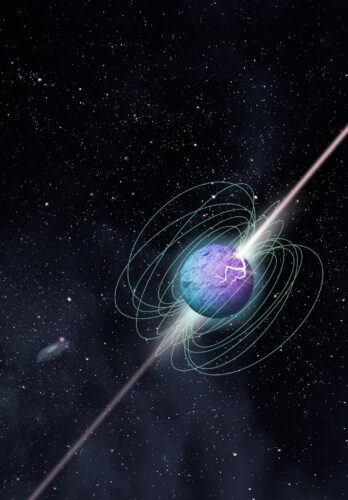The close proximity of high-energy pulses suggests that magnetars may be the source of certain fast bursts of radio radiation

New data from a Canadian-led team of astronomers, which included researchers from the McGill Space Institute and McGill University's Department of Physics, makes a strong case that magnetars—a type of neutron star believed to have a very strong magnetic field—could be the source of some fast radio bursts (FRBs). . Although many studies have been done to explain the mysterious phenomenon, their source has so far not been discovered and the subject is subject to disagreement.
First detection of a powerful burst of radio radiation from a magnetar inside the galaxy
On April 28, 2020, a team of about 50 students, postdoctoral fellows and professors from the Canadian Hydrogen Intensity Mapping Experiment (CHIME) Fast Radio Burst Collaboration discovered an unusually powerful burst of radio radiation emanating from a nearby magnetar located in the Milky Way. In a study published today in Nature, they show that the intensity of the burst of radio radiation was three thousand times greater than any magnetar measured so far, which strengthens the theory that magnetars are the source of at least some FRBs.
"We thought that if such a strong burst came from another galaxy it would be impossible to distinguish it from certain FRBs, so this really strengthens the theory that magnetars could be the cause of at least some FRBs," said Fergia Chavala, one of the co-authors on the study and a Ph.D. Senior in McGill's physics department.
Competing theories about the origin of FRBs
FRBs were first discovered more than a decade ago. At first they were thought to be singular events, but astronomers have since discovered that some of these powerful bursts of radio emission—more powerful than the energy the Sun has produced over millions to billions of years—are actually burning.
One theory hypothesizes that FRBs are extragalactic magnetars—young, highly magnetic neutron stars that occasionally burn up and release enormous amounts of energy.
"Until now, all the FRBs that telescopes like CHIME have detected have been in other galaxies, which makes it very difficult to study them in great detail," said Ziggy Pelionis, a senior doctoral student in McGill's Department of Physics and one of the co-authors of the new study. "Furthermore, the magnetar theory was not supported by observations of magnetars in our galaxy because they were found to be much less powerful than the energy released by FRBs outside the galaxy so far."
still need to confirm that all theFRBs originate from magnets
"However, due to the large differences in energetics and activity between the sources of the brightest and most active FRBs and what is observed from magnetars, perhaps younger, more energetic and active magnetars are needed to explain all the observations of FRBs," added Dr. Paul Schultz of the Dunlap Institute for Astronomy and Astrophysics at the University of Toronto.
Conclusive proof that the origin of some FRBs is magnetar will come when they simultaneously detect a burst of radio radiation and a burst of X-rays from outside the galaxy. But this will probably only be possible for nearby FRBs. Fortunately, CHIME/FRB detects these in abundance.
to the notice of the researchers
More of the topic in Hayadan:

4 תגובות
I think it is capsule heat that breaks down at a certain frequency depending on the materials involved during a rapid exothermic state of aggregation.
Surely the world will want to pump alternative energy from there without having to pay anyone. Is Trump's concern due to the fact that Biden is not going to cultivate the oil extractors, immediately unfounded. Or is the world trying to check if the cosmic balance will be violated, before they connect the seeds and plugs there.
Muriel - thanks for your attention. fixed.
Let alone the fact that they discovered this burst of radio radiation, what's more interesting is that they came to us from the future! And then they still say that the time machine does not exist? February 28, 2028 seems to me quite far from today.